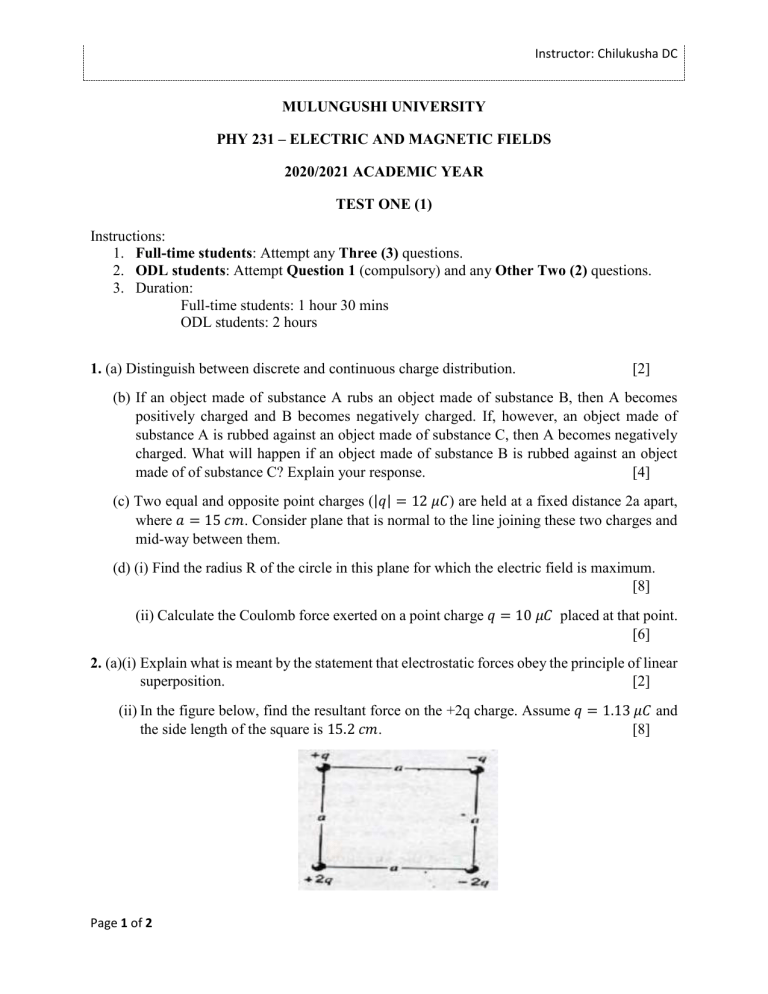
Instructor: Chilukusha DC MULUNGUSHI UNIVERSITY PHY 231 – ELECTRIC AND MAGNETIC FIELDS 2020/2021 ACADEMIC YEAR TEST ONE (1) Instructions: 1. Full-time students: Attempt any Three (3) questions. 2. ODL students: Attempt Question 1 (compulsory) and any Other Two (2) questions. 3. Duration: Full-time students: 1 hour 30 mins ODL students: 2 hours 1. (a) Distinguish between discrete and continuous charge distribution. [2] (b) If an object made of substance A rubs an object made of substance B, then A becomes positively charged and B becomes negatively charged. If, however, an object made of substance A is rubbed against an object made of substance C, then A becomes negatively charged. What will happen if an object made of substance B is rubbed against an object made of of substance C? Explain your response. [4] (c) Two equal and opposite point charges (|𝑞| = 12 𝜇𝐶) are held at a fixed distance 2a apart, where 𝑎 = 15 𝑐𝑚. Consider plane that is normal to the line joining these two charges and mid-way between them. (d) (i) Find the radius R of the circle in this plane for which the electric field is maximum. [8] (ii) Calculate the Coulomb force exerted on a point charge 𝑞 = 10 𝜇𝐶 placed at that point. [6] 2. (a)(i) Explain what is meant by the statement that electrostatic forces obey the principle of linear superposition. [2] (ii) In the figure below, find the resultant force on the +2q charge. Assume 𝑞 = 1.13 𝜇𝐶 and the side length of the square is 15.2 𝑐𝑚. [8] Page 1 of 2 Instructor: Chilukusha DC (b) A rod of length l has a uniform positive charge per unit length λ and a total charge Q. Calculate the electric field at a point P that is located along the long axis of the rod and d distance a from one end. [10] 3. (a) Distinguish between the structure of conductors and insulators at atomic level. [3] (b) (i) Show that the Electric field intensity at a point on the axis of a uniformly charged ring of radius R, a distance x from its center, is given by [5] 1 𝑄𝑥 𝐸= ̂ 3 𝑥 4𝜋𝜀0 2 2 (𝑅 + 𝑥 )2 (ii) Check the above expression in the limiting case x≫R. Does it yield the expected results? [3] (c) Consider now a uniformly charged right circular cylindrical shell having total charge 𝑄, radius 𝑅, and height ℎ. Determine the electric field at a point a distance d from the right side of the cylinder. (Hint: treat the cylinder as a collection of ring charges.) [9] 4. (a) Capacitors are often stored with a wire connected across their terminals. Why is this done? [2] (b) (i) Use Gauss Flux theorem to show that the electric field due to an infinite sheet of charge is given by 𝐸= 𝜎 2𝜀0 [4] (ii) Hence or otherwise, show that the capacitance of a parallel-plate capacitor is 𝐶= 𝜀0 𝐴 𝑑 [4] (c) Two equal but opposite charges +q and –q are separated by a distance of 10 cm in air. What value of 𝑞 will provide for an electric field strength midway between charges that will exceed the dielectric strength of air? [5] (d) Show that the energy density of a parallel plate capacitor is 1 𝑢 = 𝜀0 𝐸 2 2 END OF TEST Page 2 of 2 [5]


